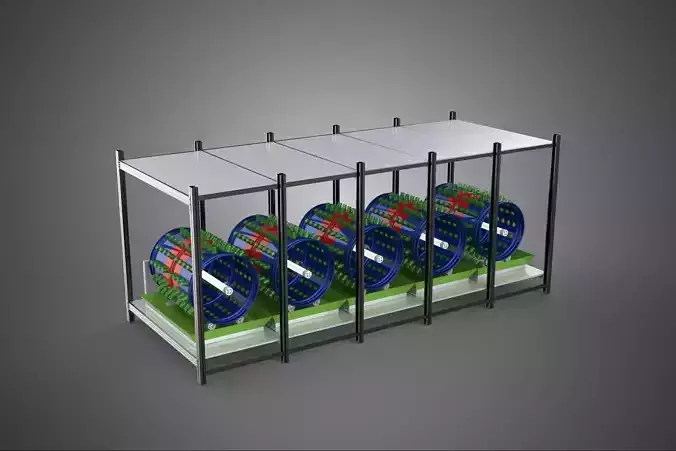1/34
High-quality 3D assets at affordable prices — trusted by designers, engineers, and creators worldwide. Made with care to be versatile, accessible, and ready for your pipeline.
Included File Formats
This model is provided in 14 widely supported formats, ensuring maximum compatibility:
• - FBX (.fbx) – Standard format for most 3D software and pipelines
• - OBJ + MTL (.obj, .mtl) – Wavefront format, widely used and compatible
• - STL (.stl) – Exported mesh geometry; may be suitable for 3D printing with adjustments
• - STEP (.step, .stp) – CAD format using NURBS surfaces
• - IGES (.iges, .igs) – Common format for CAD/CAM and engineering workflows (NURBS)
• - SAT (.sat) – ACIS solid model format (NURBS)
• - DAE (.dae) – Collada format for 3D applications and animations
• - glTF (.glb) – Modern, lightweight format for web, AR, and real-time engines
• - 3DS (.3ds) – Legacy format with broad software support
• - 3ds Max (.max) – Provided for 3ds Max users
• - Blender (.blend) – Provided for Blender users
• - SketchUp (.skp) – Compatible with all SketchUp versions
• - AutoCAD (.dwg) – Suitable for technical and architectural workflows
• - Rhino (.3dm) – Provided for Rhino users
Model Info
• - All files are checked and tested for integrity and correct content
• - Geometry uses real-world scale; model resolution varies depending on the product (high or low poly)
• • - Scene setup and mesh structure may vary depending on model complexity
• - Rendered using Luxion KeyShot
• - Affordable price with professional detailing
Buy with confidence. Quality and compatibility guaranteed.
If you have any questions about the file formats, feel free to send us a message — we're happy to assist you!
Sincerely,
SURF3D
Trusted source for professional and affordable 3D models.
More Information About 3D Model :
A CELL RACK FRAME ROW SHELF TRAY DRUM ROTARY HYDROPONIC PLANT FARM describes a sophisticated and integrated system within Controlled Environment Agriculture (CEA), designed for high-density, automated plant cultivation. This complex designation encompasses multiple structural and functional components that combine to create an optimized environment for plant growth without soil, leveraging principles of hydroponics and mechanical rotation.
At its core, this system is a type of vertical farm employing a distinct rotary mechanism. Plants are typically housed in individual cells or small containers, which are then secured into trays or specialized holders. These trays, in turn, are mounted circumferentially around the interior or exterior of a large, drum-like structure. This entire rotating assembly forms the drum rotary component. The drum is supported within a robust frame and often organized into racks or multi-tiered shelves, allowing for the stacking of multiple rotary units in rows to maximize vertical space utilization.
The primary function of the rotary mechanism is to provide uniform exposure to light, air, and nutrient solution for each plant. As the drum slowly rotates (e.g., one revolution per hour or per day), plants are systematically moved through different zones. This rotation ensures that all plants receive an equal share of light, typically provided by energy-efficient LED grow lights positioned centrally within the drum or externally. This uniform photonic exposure eliminates shadowing and optimizes Photosynthetically Active Radiation (PAR) utilization, leading to consistent growth rates and crop quality.
The hydroponic aspect means that plants receive all necessary nutrients dissolved in water, directly delivered to their root zones. The specific hydroponic method can vary but often involves aeroponics (where roots are misted with nutrient solution as they rotate through a designated zone), a modified Nutrient Film Technique (NFT), or a deep water culture (DWC) variant where roots periodically dip into a nutrient reservoir. The rotation can also assist in nutrient solution distribution or drainage, often utilizing gravity. A closed-loop system typically recycles the nutrient solution, significantly reducing water consumption compared to traditional agriculture.
The rack frame row shelf tray components emphasize the modularity and scalability of the system. The strong frame provides structural integrity for the heavy rotating drum(s) and associated equipment. Racks and shelves allow for the efficient stacking of multiple rotary units, maximizing the plant density per unit of floor area. This vertical integration is critical for urban agriculture or environments with limited land availability. Individual trays and cells ensure organized housing for plants, facilitating monitoring, harvesting, and pest/disease management.
Advantages of such a system include exceptional space efficiency, enabling high crop yields in compact footprints; significant water conservation through recirculation; faster growth cycles and higher productivity due to optimized and consistent environmental conditions; reduced risk of pests and diseases in a controlled indoor environment; and year-round production irrespective of external climate. Advanced systems often integrate environmental sensors, automated nutrient dosing, and climate control (temperature, humidity, CO2 levels) to further refine growing conditions.
This integrated approach represents a frontier in precision agriculture, catering to the growing demand for sustainable, locally sourced, and high-quality produce.
KEYWORDS: Hydroponics, Rotary Hydroponics, Vertical Farming, Controlled Environment Agriculture (CEA), Indoor Farming, Aeroponics, Nutrient Film Technique (NFT), Sustainable Agriculture, Urban Farming, Plant Cultivation, Automated Farming, Precision Agriculture, Grow Chamber, Plant Factory, Space Efficiency, Water Conservation, Crop Yield, Environmental Control, LED Grow Lights, Nutrient Delivery, Root Zone, Plant Growth, Modular Design, High-Density Cultivation, Year-Round Production, Agri-Tech, Horticultural Technology, Resource Optimization, Gravity-Assisted Systems.
REVIEWS & COMMENTS
accuracy, and usability.


































